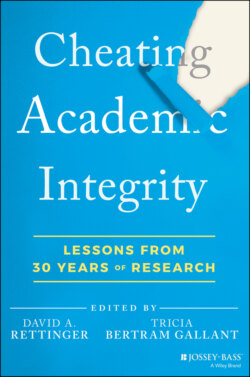Читать книгу Cheating Academic Integrity - Группа авторов - Страница 12
TIME‐LAG STUDIES OF PLAGIARISM AND CHEATING
ОглавлениеWithin the academic integrity literature, many studies can provide a one‐off estimate of plagiarism and cheating prevalence at a single point in time. Some studies have specifically investigated the prevalence of academic misconduct by students (e.g. Lim and See, 2001), while others incidentally provide an estimate of misconduct prevalence in studies examining other issues such as predictors of cheating (e.g. Roig and Caso, 2005). Such studies could be used to map historical trends in plagiarism and cheating prevalence over the past 30 years. However, the great diversity of samples, methods, and measures in these studies means that comparison of any one study with another is a comparison of an apple with an orange. Take, for example, two studies conducted in 2015: Abukari (2016) found that 45.8 percent of a sample of 488 Ghanaian students paid someone else to do their homework; in contrast, Roth (2017) found that 0.9 percent of nearly 5,000 American students bought or sold assessment work or study materials. These studies each provide a prevalence estimate of homework outsourcing and sharing where one is more than 50 times higher than the other. These differences may be attributable to the different cultural contexts, samples, and questions that students were asked.
McCabe et al. (2012) sum up concerns about, and causes for, the striking differences in estimates of cheating and plagiarism prevalence that come from dissimilar studies:
[S]ignificant disparities exist in research estimates of the percentage of college students who engage in academic dishonesty, ranging from 3% (Karlins et al., 1988) to 98% (Gardner et al., 1988). These discrepancies largely stem from differences in research methodology, including research design (e.g. survey vs. experiment), how cheating is defined and operationalized (e.g. self‐reports vs. observed or actual cheating), and the time frame examined. (p. 37).
Thus, to most accurately chart historical trends, the most valid data come from studies that have examined similar samples of students using the same measures repeatedly over time. However, not all studies with a longitudinal focus on academic misconduct measure the prevalence of plagiarism and cheating (e.g. Macale et al., 2017; Molnar, 2015). Additionally, repeated sampling over time should ideally be from surveys conducted more than twice in order to assess trends—as Curtis and Vardanega (2016) quipped “two data points do not make a trend, they make a line” (p. 1170). Remarkably, only three research programs in the last 30 years have collected data consistently, from similar college student samples that allow for a like‐with‐like comparison of general trends in the prevalence of plagiarism and cheating with more than two times of testing.
Strictly speaking, a longitudinal research design collects data from the same people on more than one occasion (Hartmann, 1992). Importantly, longitudinal studies of student cheating over decades are impossible to conduct because students typically pass through their higher education studies from commencement to graduation within a period of three to six years before entering the workforce. As Curtis and Vardanega (2016) point out, studying similar cohort groups of people at multiple points in time is a time‐lag, rather than a longitudinal, study. Therefore, to look at prevalence trends from 1990–2020, we must look at the three research programs that have used time‐lag designs.
For convenience, I will refer to the three programs of research that have conducted time‐lag studies of plagiarism and cheating prevalence by the most recent publications of their data: Stiles et al. (2018), McCabe et al. (2012), and Curtis and Tremayne (2021). The studies incorporated within these publications, their data collection years, and the number of students who completed survey measures are summarized in Table 1.
Table 1 Details of the three time‐lag studies of plagiarism and cheating 1990–2020
| Most recent report of the study | Stiles et al. (2018) | McCabe et al. (2012) | Curtis and Tremayne (2021) |
|---|---|---|---|
| Previous incremental reports of the study | Vandehey et al. (2007), Diekhoff et al. (1996) | McCabe and Trevino (1993), McCabe and Trevino (1997), McCabe et al. (2001) | Curtis and Vardanega (2016), Curtis and Popal (2011), Maxwell et al. (2006) |
| Years of data collection and number (n) of students | 1994 (n = 474) 2004 (n = 401) 2014 (n = 506) | 1990/91 (n = 2,854) 1993/94 (n = 1,744) 1999/2000 (n = 693) 2002–2012 (n = 73,738) | 2004 (n = 425) 2009 (n = 119) 2014 (n = 106) 2019 (n = 1099) |
Next, I outline the methodologies of these studies. Then a graph is presented summarizing the aggregate percentages of students who engaged in any form of plagiarism or cheating at least once over time. In all cases, these studies collected self‐report data from college students. One common methodological evolution in each of the three studies was a transition from pencil‐and‐paper to online survey data collection as technology progressed.
